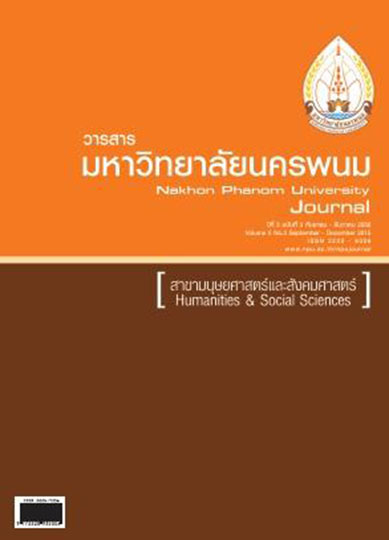การพัฒนาตัวบ่งชี้คุณภาพชีวิตครู สังกัดสำนักงานเขตพื้นที่การศึกษาประถมศึกษาสกลนคร เขต 2
Main Article Content
Abstract
การวิจัยครั้งนี้มีวัตถุประสงค์เพื่อ 1) พัฒนาตัวบ่งชี้คุณภาพชีวิตครู สังกัดสำนักงานเขตพื้นที่การศึกษาประถมศึกษาสกลนครเขต 2 และ 2) เพื่อตรวจสอบความสอดคล้องของโมเดลโครงสร้างตัวบ่งชี้คุณภาพชีวิตครูที่พัฒนาขึ้นกับข้อมูลเชิงประจักษ์ การดำเนินการมี 2 ระยะ ประกอบด้วย ระยะที่ 1 การพัฒนาตัวบ่งชี้คุณภาพชีวิตครูสังกัดสำนักงานเขตพื้นที่การศึกษาประถมศึกษาสกลนคร เขต 2โดยการวิเคราะห์เอกสารงานวิจัยและการสัมภาษณ์ผู้ทรงคุณวุฒิ เพื่อจัดทำกรอบแนวคิดและร่างตัวบ่งชี้ ใช้วิธีวิเคราะห์เนื้อหา ระยะที่ 2การตรวจสอบเพื่อยืนยันตัวบ่งชี้คุณภาพชีวิตครู โดยวิธีวิจัยเชิงปริมาณ เก็บข้อมูลจากกลุ่มตัวอย่างครูจำนวน 352 คน และวิเคราะห์ข้อมูลด้วยโปรแกรมสำเร็จรูปทางสถิติและโปรแกรมลิสเรล เครื่องมือที่ใช้ในการเก็บข้อมูลเป็นแบบสอบถามแบบมาตราส่วนประมาณค่า 5 ระดับ มีค่าดัชนีความสอดคล้องระหว่าง 0.60 – 1.00 ค่าอำนาจจำแนกรายข้อระหว่าง 0.26 - 0.74 ค่าความเชื่อมั่นทั้งฉบับโดยวิธีสัมประสิทธิ์แอลฟาของ Cronbach เท่ากับ 0.95
ผลการวิจัยพบว่า 1) ตัวบ่งชี้คุณภาพชีวิตครู สังกัดสำนักงานเขตพื้นที่การศึกษาประถมศึกษาสกลนคร เขต 2 ประกอบด้วย4 องค์ประกอบหลัก 18 องค์ประกอบย่อย 58 ตัวบ่งชี้ จำแนกเป็น ด้านครอบครัว จำนวน 13 ตัวบ่งชี้ ด้านการทำงาน จำนวน 17 ตัวบ่งชี้ด้านสุขภาพร่างกายและสุขภาพจิต จำนวน 16 ตัวบ่งชี้ และด้านสิ่งแวดล้อมทางกายภาพ จำนวน 12 ตัวบ่งชี้ ซึ่งเป็นไปตามหลักการแนวคิด และทฤษฎีที่เกี่ยวข้อง 2) โมเดลโครงสร้างคุณภาพชีวิตครู สังกัดสำนักงานเขตพื้นที่การศึกษาประถมศึกษาสกลนคร เขต 2มีความสอดคล้องกับข้อมูลเชิงประจักษ์ โดยมีค่าไค-สแควร์ (Chi-square) เท่ากับ 67.18 ค่าองศาอิสระ (df) เท่ากับ 77 ค่านัยสำคัญทางสถิติ (P-value) เท่ากับ .78 ค่าดัชนีวัดระดับความกลมกลืน (GFI) เท่ากับ .98 ค่าดัชนีวัดระดับความสอดคล้องที่ปรับแก้แล้ว (AGFI)เท่ากับ .95 และค่าความคลาดเคลื่อนในการประมาณค่าพารามิเตอร์ (RMSEA) เท่ากับ .00 ซึ่งเป็นไปตามสมมติฐานที่ตั้งไว้ เมื่อเรียงลำดับค่านํ้าหนักองค์ประกอบจากมากไปหาน้อยเป็นดังนี้ ด้านครอบครัว (.99) ด้านการทำงาน (.99) ด้านสุขภาพร่างกายและสุขภาพจิต (.98)และด้านสิ่งแวดล้อมทางกาย (.89)
The aims of this study were: 1) to develop quality of life indicators of teachers under the Office of Sakon Nakhon Primary Education Service Area 2, and 2) to examine goodness-of-fit between the structural equation modeling of the developed teacher quality of life indicators and the empirical data. This study was divided into 2 phases: 1) Phase 1 - development of quality of life indicators of teachers under the Office of Sakon Nakhon Primary Education Service Area 2 by analyzing related documents and research, interviewing experts, building a conceptual framework and drafting indicators by using a data analysis method; 2) Phase 2 - verification of teacher quality of life indicators by using a quantitative research method. Data was collected from a sample of 352 teachers and analyzed using a statistical package and the LISREL program. The tool for collecting data employed in this study was a 5-rating scale questionnaire with the indexes of item-objective congruence (IOC) ranging between .60 and 1.00, the discrimination power values of each item ranging between .26 and .74 and the overall reliability value of .95 being calculated from the Cronbach's alpha coefficient method.
The findings were as follows. 1) The quality of life indicators of teachers under the Office of Sakon Nakhon Primary Education Service Area 2 comprises 4 major components, 18 minor components and 58 indicators. These can be further divided into: 1) 13 familial indicators, 2) 17 work-related indicators, 3) 16 physical and mental health indicators, and 4) 12 physical environment indicators. These indicators were based on related principles, concepts and theories. 2) Structural equation modeling of quality of life of teachers under the Office of Sakon Nakhon Primary Education Service Area 2 had goodness-of-fit with the empirical data with the Chi-square value = 67.18, degree of freedom (df) = 77, P-value = .78, goodness-of-fit (GFI) value = .98, adjusted goodness-of-fit (AGFI) value = .95 and root mean square error of approximation (RMSEA) value = .00. Therefore, the hypothesis was proven true by the aforementioned outcome. When factor loading values of the components are ordered from higher to lower, their appearances are as follows: familial component (.99), work-related component (.99), physical and mental health component (.98), and physical environment component (.89).


